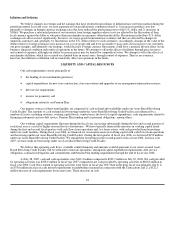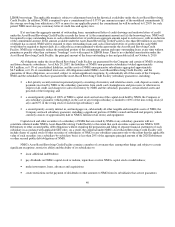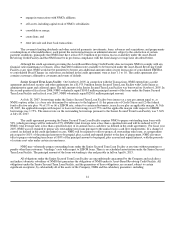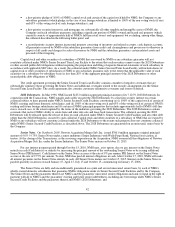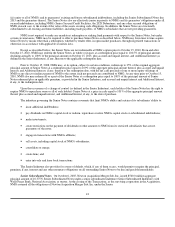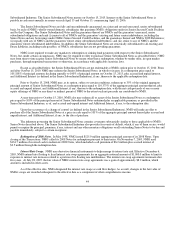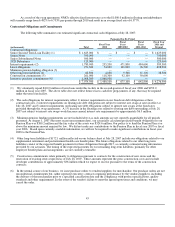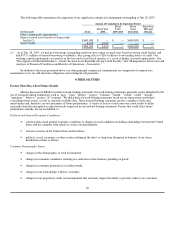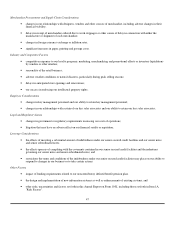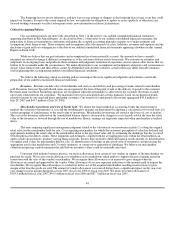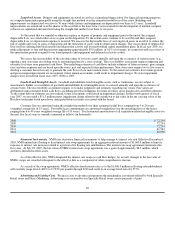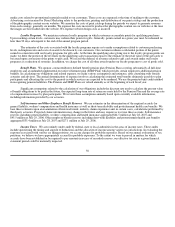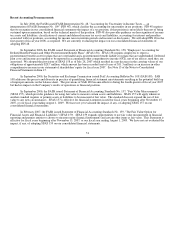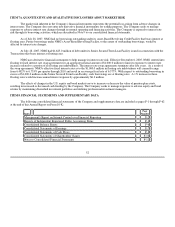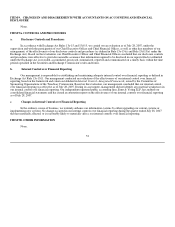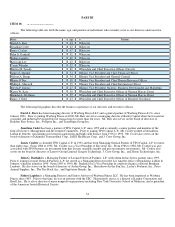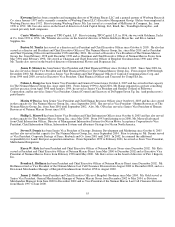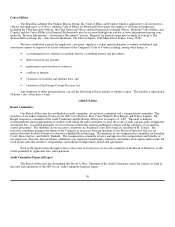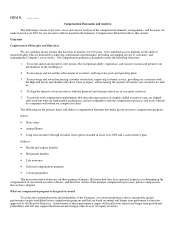Neiman Marcus 2006 Annual Report Download - page 51
Download and view the complete annual report
Please find page 51 of the 2006 Neiman Marcus annual report below. You can navigate through the pages in the report by either clicking on the pages listed below, or by using the keyword search tool below to find specific information within the annual report.
The foregoing factors are not exhaustive, and new factors may emerge or changes to the foregoing factors may occur that could
impact our business. Except to the extent required by law, we undertake no obligation to update or revise (publicly or otherwise) any
forward-looking statements to reflect subsequent events, new information or future circumstances.
Critical Accounting Policies
Our accounting policies are more fully described in Note 1 of the notes to our audited consolidated financial statements
appearing elsewhere in this Annual Report. As disclosed in Note 1 of the notes to our audited consolidated financial statements, the
preparation of financial statements in conformity with generally accepted accounting principles requires us to make estimates and
assumptions about future events. These estimates and assumptions affect the amounts of assets, liabilities, revenues and expenses and the
disclosure of gain and loss contingencies at the date of our audited consolidated financial statements appearing elsewhere in this Annual
Report on Form 10-K.
While we believe that our past estimates and assumptions have been materially accurate, the amounts we have currently
estimated are subject to change if different assumptions as to the outcome of future events were made. We evaluate our estimates and
judgments on an ongoing basis and predicate those estimates and judgments on historical experience and on various other factors that we
believe to be reasonable under the circumstances. We make adjustments to our assumptions and judgments when facts and circumstances
dictate. Since future events and their effects cannot be determined with absolute certainty, actual results may differ from the estimates
used in preparing the accompanying audited consolidated financial statements.
We believe the following critical accounting policies encompass the more significant judgments and estimates used in the
preparation of our audited consolidated financial statements.
Revenues. Revenues include sales of merchandise and services and delivery and processing revenues related to merchandise
sold. Revenues from our Specialty Retail stores are recognized at the later of the point of sale or the delivery of goods to the customer.
Revenues from our Direct Marketing operation are recognized when the merchandise is delivered to the customer. Revenues exclude
sales taxes collected from our customers. We maintain reserves for anticipated sales returns primarily based on our historical trends
related to returns by our retail and direct marketing customers. Our reserves for anticipated sales returns aggregated $48.8 million at
July 28, 2007 and $43.7 million at July 29, 2006.
Merchandise Inventories and Cost of Goods Sold. We utilize the retail method of accounting.Under the retail inventory
method, the valuation of inventories at cost and the resulting gross margins are determined by applying a calculated cost-to-retail ratio, for
various groupings of similar items, to the retail value of inventories. Merchandise inventories are stated at the lower of cost or market.
The cost of the inventory reflected on the consolidated balance sheets is decreased by charges to cost of goods sold at the time the retail
value of the inventory is lowered through the use of markdowns. Hence, earnings are negatively impacted when merchandise is marked
down.
The areas requiring significant management judgment related to the valuation of our inventories include (1) setting the original
retail value for the merchandise held for sale, (2) recognizing merchandise for which the customer's perception of value has declined and
appropriately marking the retail value of the merchandise down to the perceived value and (3) estimating the shrinkage that has occurred
between physical inventory counts. These judgments and estimates, coupled with the averaging processes within the retail method can,
under certain circumstances, produce varying financial results. Factors that can lead to different financial results include (1) determination
of original retail values for merchandise held for sale, (2) identification of declines in perceived value of inventories and processing the
appropriate retail value markdowns and (3) overly optimistic or conservative estimation of shrinkage. We believe our merchandise
valuation and pricing controls minimize the risk that our inventory values could be materially misstated.
Consistent with industry business practice, we receive allowances from certain of our vendors in support of the merchandise we
purchase for resale. We receive certain allowances to reimburse us for markdowns taken and/or to support the gross margins earned in
connection with the sales of the vendor's merchandise. We recognize these allowances as an increase to gross margin when the
allowances are earned and approved by the vendor. Other allowances we receive represent reductions to the amounts paid to acquire the
merchandise. We recognize these allowances as a reduction in the cost of the acquired merchandise resulting in an increase to gross
margin at the time the goods are sold. The amount of vendor allowances we received did not have a significant impact on the year-over-
year change in gross margin during fiscal year 2007, fiscal year 2006 or fiscal year 2005. We received vendor allowances of
$103.4 million in fiscal year 2007, $94.5 million in fiscal year 2006 and $87.7 million in fiscal year 2005.
48


